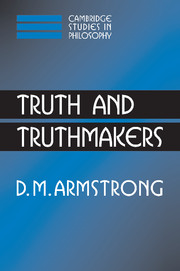Book contents
- Frontmatter
- Contents
- Preface
- 1 An introduction to truthmakers
- 2 The general theory of truthmaking
- 3 Epistemology and methodology
- 4 Properties, relations and states of affairs
- 5 Negative truths
- 6 General truths
- 7 Truthmakers for modal truths, part 1: possibility
- 8 Truthmakers for modal truths, part 2: necessity
- 9 Numbers and classes
- 10 Causes, laws and dispositions
- 11 Time
- References
- Index
7 - Truthmakers for modal truths, part 1: possibility
Published online by Cambridge University Press: 22 September 2009
- Frontmatter
- Contents
- Preface
- 1 An introduction to truthmakers
- 2 The general theory of truthmaking
- 3 Epistemology and methodology
- 4 Properties, relations and states of affairs
- 5 Negative truths
- 6 General truths
- 7 Truthmakers for modal truths, part 1: possibility
- 8 Truthmakers for modal truths, part 2: necessity
- 9 Numbers and classes
- 10 Causes, laws and dispositions
- 11 Time
- References
- Index
Summary
INTRODUCTION
The question of truthmakers for modal truths is in considerable disarray. Many philosophers who are sympathetic to the idea of truthmakers are nevertheless influenced by the Tractatus picture, where contingent truths are made true by the atomic facts (with some apparent uncertainty about contingent negative and contingent general truths), but modal truths, in particular necessary truths, lack truthmakers because they ‘all say the same thing, viz. nothing’.
THE POSSIBILITY PRINCIPLE
We are concerned with the weakest grade of possibility: metaphysical possibility. Necessities are possibilities. If p is necessary, then p is possible. Contingent truths are also possibilities. (A contingent proposition is one where both the proposition and its contradictory, p &¬ p, are possible.) If p is contingently true, then p is possible. But the philosophically interesting possibilities are the contingent falsities. Call these propositions the ‘mere possibilities’. These yield a body of modal truths: truths having the form ‘it is possible that p’ where, however, p itself is false (¬p &◇ p). What truthmakers shall we propose for these ‘truths of mere possibility’?
It seems to me very surprising that so many good philosophers consider that huge metaphysical commitments must be made in order to give an account of these truths. David Lewis (1986) postulated a whole pluriverse: ‘the worlds in all their glory’. Alvin Plantinga (1974) rejects these other worlds, but adds to this world, our world, an uncountable multitude of sets of propositions, each set a way that the world might have been, but is in fact not.
- Type
- Chapter
- Information
- Truth and Truthmakers , pp. 83 - 94Publisher: Cambridge University PressPrint publication year: 2004



